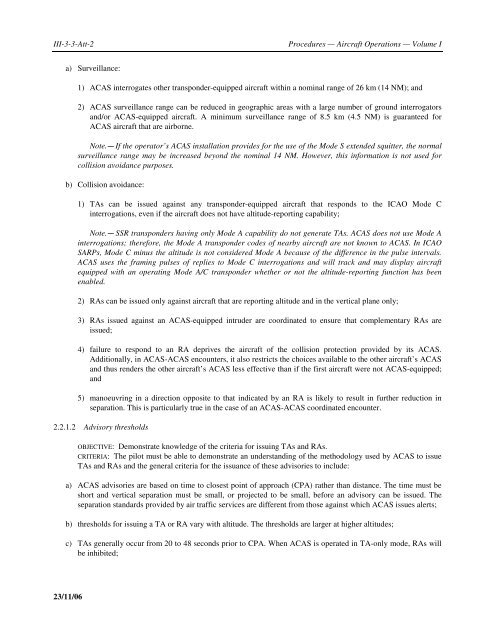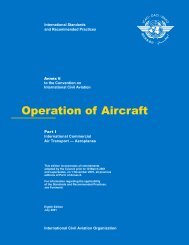Aircraft Operations
Doc 8168 Aircraft Operations, Volume I Flight Procedures
Doc 8168 Aircraft Operations, Volume I Flight Procedures
- No tags were found...
You also want an ePaper? Increase the reach of your titles
YUMPU automatically turns print PDFs into web optimized ePapers that Google loves.
III-3-3-Att-2<br />
Procedures — <strong>Aircraft</strong> <strong>Operations</strong> — Volume I<br />
a) Surveillance:<br />
1) ACAS interrogates other transponder-equipped aircraft within a nominal range of 26 km (14 NM); and<br />
2) ACAS surveillance range can be reduced in geographic areas with a large number of ground interrogators<br />
and/or ACAS-equipped aircraft. A minimum surveillance range of 8.5 km (4.5 NM) is guaranteed for<br />
ACAS aircraft that are airborne.<br />
Note. If the operator’s ACAS installation provides for the use of the Mode S extended squitter, the normal<br />
surveillance range may be increased beyond the nominal 14 NM. However, this information is not used for<br />
collision avoidance purposes.<br />
b) Collision avoidance:<br />
1) TAs can be issued against any transponder-equipped aircraft that responds to the ICAO Mode C<br />
interrogations, even if the aircraft does not have altitude-reporting capability;<br />
Note. SSR transponders having only Mode A capability do not generate TAs. ACAS does not use Mode A<br />
interrogations; therefore, the Mode A transponder codes of nearby aircraft are not known to ACAS. In ICAO<br />
SARPs, Mode C minus the altitude is not considered Mode A because of the difference in the pulse intervals.<br />
ACAS uses the framing pulses of replies to Mode C interrogations and will track and may display aircraft<br />
equipped with an operating Mode A/C transponder whether or not the altitude-reporting function has been<br />
enabled.<br />
2) RAs can be issued only against aircraft that are reporting altitude and in the vertical plane only;<br />
3) RAs issued against an ACAS-equipped intruder are coordinated to ensure that complementary RAs are<br />
issued;<br />
4) failure to respond to an RA deprives the aircraft of the collision protection provided by its ACAS.<br />
Additionally, in ACAS-ACAS encounters, it also restricts the choices available to the other aircraft’s ACAS<br />
and thus renders the other aircraft’s ACAS less effective than if the first aircraft were not ACAS-equipped;<br />
and<br />
5) manoeuvring in a direction opposite to that indicated by an RA is likely to result in further reduction in<br />
separation. This is particularly true in the case of an ACAS-ACAS coordinated encounter.<br />
2.2.1.2 Advisory thresholds<br />
OBJECTIVE: Demonstrate knowledge of the criteria for issuing TAs and RAs.<br />
CRITERIA: The pilot must be able to demonstrate an understanding of the methodology used by ACAS to issue<br />
TAs and RAs and the general criteria for the issuance of these advisories to include:<br />
a) ACAS advisories are based on time to closest point of approach (CPA) rather than distance. The time must be<br />
short and vertical separation must be small, or projected to be small, before an advisory can be issued. The<br />
separation standards provided by air traffic services are different from those against which ACAS issues alerts;<br />
b) thresholds for issuing a TA or RA vary with altitude. The thresholds are larger at higher altitudes;<br />
c) TAs generally occur from 20 to 48 seconds prior to CPA. When ACAS is operated in TA-only mode, RAs will<br />
be inhibited;<br />
23/11/06












